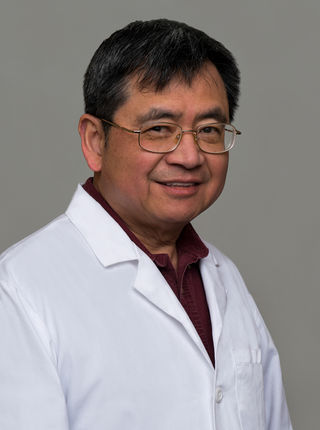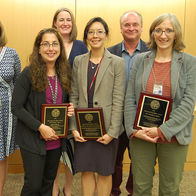Parkson Lee-Gau Chong, PhD
Professor, Medical Genetics and Molecular Biochemistry
Professor, Center for Substance Abuse Research
Professor, Biomedical Education and Data Science

- Contact Information
-
- About Me
-
Research Interests
Project 1: Bipolar Tetraether Lipid Membranes: Physical Properties, and Technological Applications
The long-term goals of this research are to understand how the Archaea live in extreme environments and to use the Archaeal bipolar tetraether lipids for technological applications. The Archaea are curious and remarkable organisms; and, their lipids are structurally distinctly different from their bacterial and eukaryotic counterparts. The native habitat of the thermoacidophilic archaeon Sulfolobus acidocaldarius, which is the focus of this research, is hot (65-80 oC) and acidic (pH 2-3) sulfur springs. The plasma membrane of S. acidocaldarius not only serves as a barrier between the low pH extracellular environment and the neutral pH intracellular compartment (pH 6.5), but also performs proton pumping and other cellular activities at high temperatures. The ability of the plasma membrane to achieve these goals in extreme environments is not clearly understood, although there is evidence suggesting that it has something to do with its unique bipolar tetraether lipid structures which contain cyclopentane rings, branched methyl groups, ether linkages, and sugar moieties. The objective of this research is to elucidate the physical origin of the remarkable thermal, chemical, and mechanical stability of the archaeal plasma membrane via a systematic study on the physical properties of liposomes composed of bipolar tetraether lipids (specifically, polar lipid fraction E, PLFE) isolated from S. acidocaldarius. Fluorescence spectroscopy and microscopy, photon correlation spectroscopy, FT-IR, small angle X-ray scattering, high-pressure probe techniques, pressure perturbation calorimetry, electrical impedance spectroscopy, differential scanning calorimetry, electron microscopy, proteomics, and molecular modeling are the major tools used in this research. Membrane properties being investigated include solute permeability, molecular packing, vesicle fusion, compressibility, free volume and volume fluctuations, lateral diffusion, shear stress response, and protein-lipid interactions. These studies will give molecular insights into the structure-function relationship of thermoacidophilic archaeal membranes and may also lead to the development of PLFE liposomes or films for applications in coating, storage, membrane protein crystallization, and targeted drug delivery.
Project 2: Sterol Superlattices: physical properties, biological functions, and technological applications
Sterol superlattice is a novel concept for understanding the structural and functional role of cholesterol in membranes. This concept was first proposed from our laboratory in 1994 and last refined in 2012. The concept of sterol superlattice formation is depicted here. The rectangle-like objects represent a lipid membrane, where regular (shaded areas) and irregular (blank areas) regions coexist. In regular regions, sterol molecules are regularly distributed into either hexagonal or centered rectangular superlattices within the host lipid matrix. There is a biphasic change in proportion of irregular region to regular region (R, solid line), membrane free volume (V, solid line), and the perimeter of regular region (P, dashed line) with membrane cholesterol content in the neighborhood of a critical sterol mole fraction Cr (e.g., 20.0, 22.2, 25.0, 33.3, 40.0 and 50.0 mol% sterol in diacylphosphoacylglycerides). The Cr values can be predicted from the sterol superlattice theories. The perimeter of the regular region is proportional to the size of the regular region. Thus the perimeter (P) of the regular regions may increase abruptly at Cr causing a large increase in the interfacial area between the regular and irregular regions, making sterols at Cr more exposed to the aqueous phase than sterols at non-Cr. We have previously shown that the extent of sterol superlattice regulates the activities of surface acting enzymes (e.g., phospholipase A2 and cholesterol oxidase), drug partitioning into membranes, drug release from lipsomes and its subsequent cytotoxicity on mammary cancer cells, and free radical-induced sterol oxidation. We will continue to elucidate the importance of sterol superlattice in membrane functions and cellular activities. Our current research addresses the following questions: (1) Do sterol superlattices and membrane rafts share the same physical origin? (2) What is the role of sterol superlattice in signal transduction, lipid metabolism, lipid trafficking, and inflammatory responses? (3) How to use the concept of sterol superlattice to develop new technological applications (a US patent (entitled: a sensitive method to assess the potency and possible adverse effects of anti-oxidants) was awarded in 2012). These studies may shed light on the etiological role of cholesterol in cardiovascular disease, Alzheimer’s disease, and other disorders.
- Education, Training & Credentials
-
Educational Background
- PhD, University of Illinois at Champaign-Urbana
- MS, Catholic University of America
- BS, Tsing-Hua University
- Publications
-
Digital Bibliography

